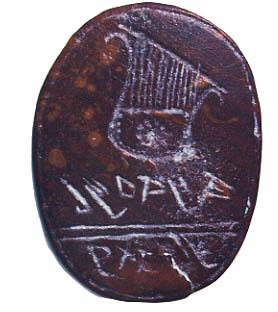Image Details

The Israel Department of Antiquities and Museums/Israel Museum, Jerusalem
Ma> adanah’s seal. This brown-jasper, seventh-century B.C. seal, only 1/2 by 3/4 by 1/4 inch, bears an engraved lyre, and two lines of ancient Hebrew script The inscription, written as a mirror-image so that its impression in clay can be read correctly, says: “(Belonging) to Ma> adanah, the king’s daughter.” The previously unknown, name “Ma> adanah” derives from a Hebrew, root meaning “delight.”
The lyre is the asymmetrical type, known as a kinnor. It is distinguished by its vertical arms of unequal length. Twelve strings attach to the crossbar at top. The soundbox at the bottom of the instrument has a string of pearl-like decorations along the outer edge and a rosette in the center.
The nebel, a related type of lyre, is larger, with symmetrical arms, and was usually reserved for religious functions in his denunciation of the marzeah, Amos decries using the nebel for “idle songs.”
